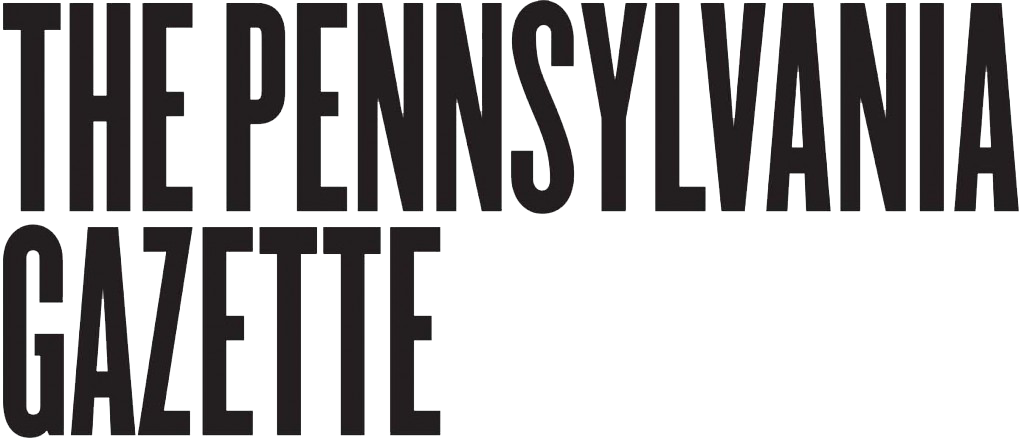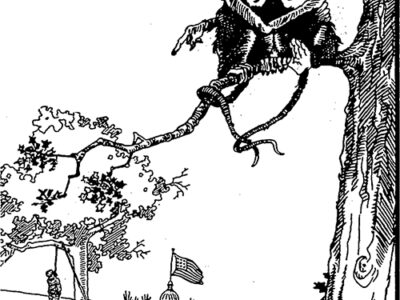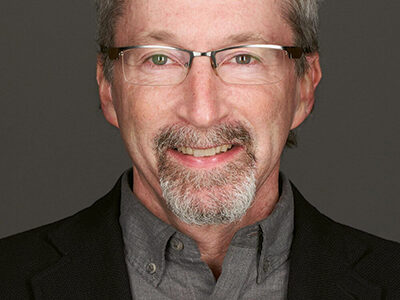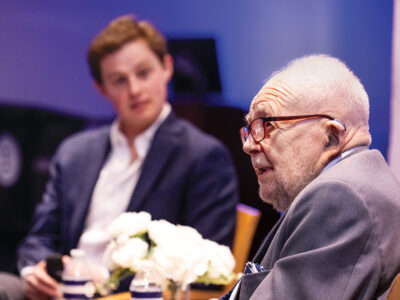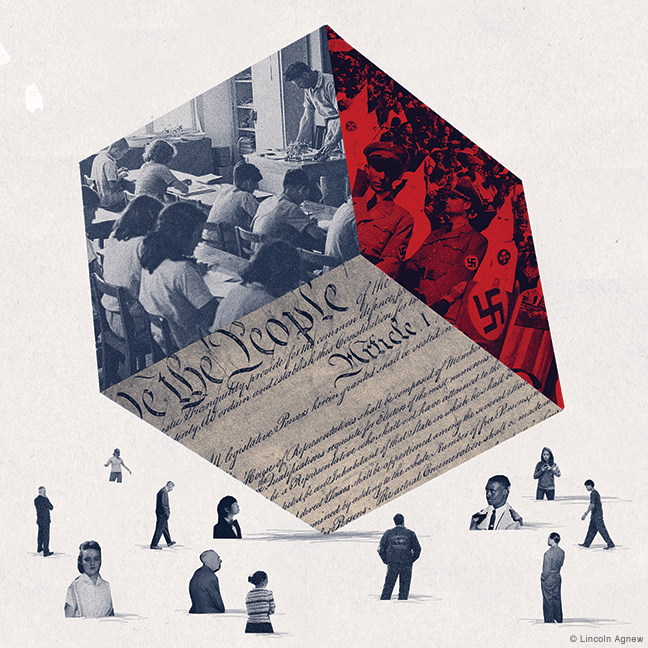
Two new books by Penn faculty explore how free expression on campus became so fraught and what to do about it.
By Jack Schneider | Whatever happened to freedom of expression at American colleges and universities? Skim the news and it’s easy to come away with the impression that the push for trigger warnings and safe spaces has overregulated what can and can’t be said. Certainly we want students to be protected from personal attack. But we also value constitutionally protected speech. How, then, to balance these aims?
In Free Speech on Campus, (Penn Press, 2017) Sigal R. Ben-Porath, a professor in the Graduate School of Education (GSE), makes the case that before leaping to judgment, we need to recognize the unique purpose of higher education. Even the brightest students, she reminds us, are still young adults, and colleges serve a pivotal role in helping them develop their own ideas and perspectives. In other words, though campus quads may resemble public plazas, they serve distinctly different audiences. Consequently, the principle of free speech might “look different on a college campus than it does in the town’s square.”
Differences in maturity aside, college campuses also have to contend with a history of exclusion and inequity. Of the 11 million students enrolled in degree-granting postsecondary institutions in 1976, over nine million were white—a majority of them male, and most of them from middle- and upper-income families. These disproportional ratios may have changed over the past four decades, but traditional majorities still tend to dominate college and university campuses.
As Ben-Porath sees it, the newly widespread sensitivity to the needs of women, minority students, and other previously marginalized groups does not reflect a disregard for freedom of speech. Rather, it reflects “a commitment to open-minded inquiry and expression”—a core component of learning. Because such inquiry is “most vibrant, most broad, and ultimately most successful when all are able to participate in it,” she argues, colleges need to support ideas and perspectives that have not been equally or adequately represented. The goal isn’t to mute unpopular expression. Instead, it is to ensure that learning is not inhibited—either for historically marginalized students who may be struggling to find their voices, or for other students who might benefit from exposure to those less dominant voices.
Does this mean that traditional majorities on campus must sit silent whenever their opinions are at odds with minority viewpoints? Not at all. According to Ben-Porath, the key is to distinguish between dignitary safety and intellectual safety. Dignitary safety—the sense of being an equal member of the community whose contributions are valued—is a prerequisite for learning. It is what enables students to share their views without fear, however historically underrepresented they may be. Intellectual safety, on the other hand, is the refusal to listen to challenges, and has no home on campus. The Middlebury undergraduates who ran conservative political scientist Charles Murray off campus in March, Ben-Porath suggests, accomplished little. Additionally, it precluded the kind of facilitated dialogue that might have given clearer voice to those who oppose Murray’s dubious views on race. In order to learn, we need to be respected; but we also need to encounter disputed views. Higher education can encourage that, she insists, even if there’s no blueprint for doing so.
Such work, of course, is not solely the burden of higher education. In fact, it would be naïve to suggest that colleges and universities are even the best places to prepare future citizens for the rigors and turbulence of public life. Before arriving on campus, we might recall, young people spend more than a decade in primary and secondary school. And because our tax-supported K–12 system is open to all, it has a far broader reach than colleges and universities do.
Why, then, do public schools teach controversial issues so rarely? In another new book, The Case for Contention (University of Chicago Press), Jonathan Zimmerman, a professor of the history of education at GSE, has teamed up with philosopher Emily Robertson to answer that question.
One challenge is that, unlike college students, the young people in American elementary, middle, and high schools are minors. Not only are they more impressionable than their college-going counterparts, but they also tend to reside in their parents’ homes, where particular social and economic viewpoints have been encouraged. Yet teachers need not address the most polarizing topics—what Zimmerman and Robertson call “maximally controversial” issues—in order to cultivate skills of debate and deliberation. If there are topics that will tear a classroom apart, they can be avoided. Some controversy, however, must be taken up in the cause of helping students develop the capacity to sort through it.
But where is the space in the curriculum to do that? As Zimmerman notes in his half of the book—a historical perspective on how schools have taught, or more often not taught controversial issues over time—teachers at the K–12 level must work within a framework of subject matter standards and high-stakes tests from which college instructors are free. In Riverview Gardens, for instance—the school district near Ferguson, Missouri, where Michael Brown was killed—students did not address the incident in school. The issue, one official report dryly observed, was not that the matter was too volatile to take up but rather that the need to prepare students for state standardized tests left “too few educational hours available.”
Primary and secondary school teachers also have cultural barriers to overcome. Unlike their counterparts in other countries or in other white-collar occupations, American teachers have long suffered from low status. While their work is generally seen as having great social importance, it is also perceived as relatively easy. Too many people, in other words, think they know better than teachers what should be taught in school and, as a result, maintain the view that teachers should generally keep quiet and leave instruction in such matters to parents.
Even if they had that freedom, though, a lack of training in the teaching of controversial issues has perpetuated the status quo. Teachers, as sociologist Dan Lortie once observed, undergo an “apprenticeship of observation” for 13 years as students—a phenomenon without parallel in any other field. Well before they have even decided to enter the profession, future teachers have spent years absorbing messages about what teachers do and don’t do in classrooms. Thus, when teachers avoid addressing controversial issues, they not only fail to develop key citizenship skills among their pupils, but they also set a precedent for future teachers.
Because school practices perpetuate themselves across time, The Case for Contention reminds us that we must be wary of any retreat to intellectual safe spaces, however ostensibly temporary. Clampdowns on the teaching of controversial issues during times of perceived crisis, Zimmerman shows, linger well after those periods. Students who were denied the ability to discuss the trial of Sacco and Vanzetti or the theory of evolution eventually became teachers unprepared to teach about communism or the internment of Japanese. This inter-generational stifling of debate and deliberation has led us to the present, in which classroom educators all too often feel ill-qualified to teach about issues like police brutality, climate change, or immigration.
Certainly there have always been exceptions. In every period, teachers have challenged orthodoxies and helped students navigate disputed issues. But they have done so at great personal risk. Even today, school board policies typically treat all controversial issues as if they were maximally controversial, and teachers can find themselves out of work for simply doing their jobs. What about their First Amendment rights? For the most part, courts have found that teachers check those at the door. As the Colorado Supreme Court wrote in 1998, “It cannot be left to individual teachers to teach what they please.” And as Zimmerman sums up a 2006 Supreme Court case—Garcetti v. Ceballos—“public employees do not have free-speech rights at work; instead, their words belong to their employer.”
That’s a horrible shame. Teachers, Zimmerman and Robertson assert, aren’t clerks or mouthpieces for the state. They’re professionals tasked with shaping our future. At our own peril, we overlook the fact that schoolteachers represent our best shot at cultivating perceptive, empathetic, and evidence-oriented citizens.
The good news is that if we take the longer historical view, we can see steady progress over time. In fact, Zimmerman and Robertson argue, “teaching controversial issues has become the official ‘best practice’ in American schools.” Progress just happens to be unfolding slowly. Perhaps now, then—in a period of seemingly unrivalled controversy—it’s time to take seriously the question of how we might speed that process up.
Jack Schneider is a historian of education and the author of Beyond Test Scores: A Better Way to Measure School Quality.
